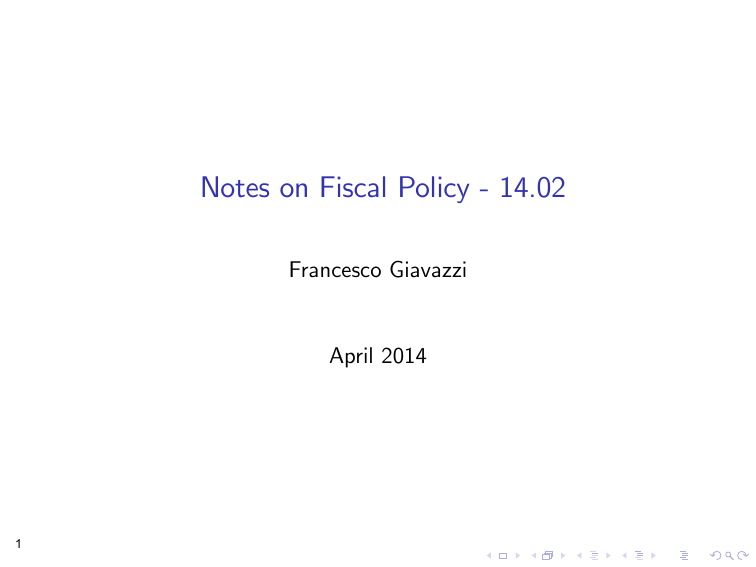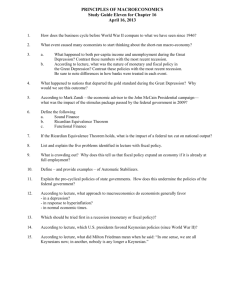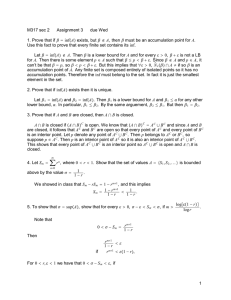
Notes on Fiscal Policy - 14.02
Francesco Giavazzi
April 2014
1
The intertemporal dimension of Fiscal Policy
I
When discussing Fiscal Policy we must start by recognizing
that countries (and governments) are in for the long term
I
They don’t need to balance their books year-by-year:
I
I
2
they can spend in excess of tax revenue today (running up
debt)
provided they will be able to pay back their debt in the future
thanks to tax revenues in excess of spending (otherwise
households will not buy government bonds)
I
That’s why – in order to understand Fiscal Policy – we need
to be able to value streams of income that will come at some
time in the future
I
The Present Value of a stream of income is the value today
(time t0 ) of a stream of income that will ‡ow between t0 and
some future date, say t0 + T
Valuing today goods that will be received tomorrow
I
Assume the economy has a technology to transfer goods from
today (period t) to tomorrow (period t + 1). For instance one
unit of corn used as seed and planted today yields (1 + r )
units of corn tomorrow
yt +1 = (1 + r ) yt
I
Then the price of a unit of good at time t + 1 relative to a
unit of good at time t (i.e. the number of units of t good
required to obtain 1 unit of t + 1 good)
1
[units of goods at time t ]
=
(1 + r )
[units of goods at time t + 1]
I
3
Thus if one wants to add up the two goods at time t, the way
to do it is
yt +1
yt +
1
( + r)
A more realistic consumption function
Consumption also depends on wealth
I To start thinking about Fiscal Policy it is useful to move a step
beyond the consumption function we used so far and realize that
consumption also depends on a household’s wealth
C = C Y disp , Wealth
Wealth = W …nancial + W housing + PDV (Y disp )
I The …rst term is …nancial wealth (stocks and bonds), the second is
the value of the family’s house (because they can use it as
"collateral" to borrow from a bank), the third is human wealth, the
value of expected income (net of taxes) over a lifetime: if you attend
an MBA you can go to the bank and ask for a loan anticpating you
will land a job on Wall Street (we shall see in a minute what are the
consequences if the bank refuses to lend you the money)
PDV (Y disp ) =
4
T
∑
i =0
Yt +i
Tt + i
(1 + r )i
How can Fiscal Policy a¤ect consumption ?
5
I
The dependency of consumption on wealth is useful to
understand how Fiscal Policy a¤ects consumption and thus
output
I
To see why this is the case, we begin by considering
intertemporal budget constraints
Does it matter how a government …nances G ?
I
Assume thre are only two periods. The government’s
intertemporal budget constraint, i.e. its budget constraint
over the two periods is
T1 +
I
The households’intertemporal budget constraint— assume for
the moment that …nancial and housing wealth are zero, so
that the only form of wealth is PDV (Y disp )— is
C1 +
6
T2
G2
= G1 +
(1 + r )
(1 + r )
C2
= (Y1
(1 + r )
T1 ) +
(Y2 T2 )
(1 + r )
The irrelevance of the government’s …nancial policy
Assume now that households realize that the government is subject
to an intertemporal budget constraint and consider two cases
1. The government budget is balanced in each period
T1 = G1 ,
T2 = G2
then
C1 +
C2
(1 + r )
= (Y1
= (Y1
(Y2 T2 )
(1 + r )
(Y2 G2 )
G1 ) +
(1 + r )
T1 ) +
2.
T1 = 0,
G1 = B,
T2 = G2 + B (1 + r )
substituting we still get
C1 +
7
C2
= (Y1
(1 + r )
G1 ) +
(Y2 G2 )
(1 + r )
Ricardian Equivalence
I
From 1. and 2. we see that they way the government …nances
a given level of spending makes no di¤erence. All that matters
is PDV (G ) = G1 + (1G+2r )
I
This result is known as Ricardian Equivalence from David
Ricardo the British economist who …rst noted this
I
I
8
in his Essay on the Funding System (1820) Ricardo studied
whether it makes a di¤erence to …nance a war with the £ 20
million in current taxes or to issue government bonds with
in…nite maturity (consols) and annual interest payment of £ 1
million in all following years …nanced by future taxes
at the assumed interest rate of 5%, Ricardo concluded that
there is no di¤erence between the two modes: 20 millions in
one payment, 1 million per annum for ever, or £ 1,2 million for
45 years are all precisely of the same value
Private Consumption and Government Spending
I
0
Assume G1 increases to G1 > G1 , while G2 does not change
I
0
(Y 2 G 2 )
(1 +r )
Y1
G1 +
C1 +
C2
(1 +r ) jG
1
C2
(1 +r ) jG 0
1
(Y G )
G1 ) + (12 +r )2
= C1 +
= (Y1
<
C
9
I
d C 1 + (1 +2r )
dG 1
I
the opposite sign compared with what we have learned so far
<0
Expansionary …scal contractions: Denmark, 1983-86
(numbers are average yearly growth rates over the period indicated)
1979
G
T
(G T )
∆ debt
∆ Y disposable
C
I
GDP
+ 4.0
- 0.03
+ 1.8
+10.2
+ 2.6
- 0.8
- 2.9
+ 1.3
82
1983
86
0.0
+ 1.3
- 1.8
0.0
- 0.3
+ 3.7
+12.7
+ 3.2
Sourse: Giavazzi, F. and M. Pagano 1990 “Can Severe Fiscal Contractions Be Expansionary?"
10
I
This means that a …scal contraction can be expansionary: if
consumption increases enough to more than compensate the
reduction in G
I
Fiscal contractions can be good news for the economy
Expansionary contractions: How can this be possible ?
I
if Ricardian Equivalence holds
C
I
I
d C 1 + (1 +2r )
dG 1
since Y = C + G
I dY 1
dG 1
11
<0
(forgetting I )
?
I
but you could make the argument also for I :
I
then
dY
dG 1
? is even more likely
dI
dG
<0
The limits of Ricardian Equivalence
I We will now show that the result that the government’s …nancial
policy is irrelevant (or Ricardian Equivalence) depends on a few
strong assumptions
I Ricardo himself had doubts. In the same essay he went towrite:
"But the people who paid the taxes never so estimate them, and
therefore do not manage their private a¤airs accordingly. We are
too apt to think that the war is burdensome only in proportion to
what we are at the moment called to pay for it in taxes, without
re‡ecting on the probable duration of such taxes. It would be
di¢ cult to convince a man possessed of £ 20,000, or any other sum,
that a perpetual payment of £ 50 per annum was equally
burdensome with a single tax of £ 1000."
I In other words, only if people had rational expectations they would
be indi¤erent as to when they pay taxes
12
The limits of Ricardian Equivalence (cont.)
I
The assumptions needed to obtain the Ricardian Equivalence
result are two
1. The horizon of households corresponds to that of the
government. In other words, people think they will pay all the
taxes the government will eventually have to levy, i.e. they will
not leave debts (future taxes to pay) to their children to pay
2. People can freely borrow
13
The limits of Ricardian Equivalence (cont.)
I
We now consider what happens if these conditions fail,
namely if
1. Households’horizon is shorter than that of the government
2. Households cannot freely borrow against their expected future
income
14
1. Households’horizon is shorter than that of the
government
I
if people plan to be around in period 2
I
I
I
15
C1 +
C2
(1 +r )
= (Y1
G1 ) +
(Y 2 G 2 )
(1 +r )
if people anticipate that the government will wait period 3 to
balance its books (T2 = 0, T3 = B (1 + r )2 ) and think they
will not be around in period 3, then
I
I
8
9
< T1 = 0
=
G1 = B , T2 = B (1 + r )
:
;
G2 = 0
C1 +
C2
(1 +r )
= Y1 +
Y2
(1 +r )
d C1 +
C2
(1 +r )
In this case
dG1
= 0 not < 0 !
2. Liquidity constraints (people cannot borrow on the
expectation of higher future income)
I
to keep the algebra simple let
G1 = G2 = G
C1 = C2 = C
r =0
Y1 = Y2 = Y
I
then the max achievable level of consumption is
C1 +
I
C2
= 2C = 2Y
(1 + r )
and the optimal path of consumption is
C1 = C2 = C = Y
16
2G
G
Liquidity Constraints (cont.)
I
Assume all taxes are levied in t = 1
I
I
17
T2 = 0
T1 = 2G
along the optimal path C1 = C2 = C = Y
I
thus in t = 1
C > Ydisp
1
Y1disp
I
and in t = 2
C < YDisp
2
Y2disp = Y = and C = Y
=Y
G
2G and C = Y
G so that
G so that
but if households cannot borrow in t = 1 the optimal path of
consumption cannot be achieved
Discussion
I So far we have assumed
Y1 and Y2 exogenous. In particular we
have assumed that the level of output does not respond to G .
I We have thus considered what are the e¤ects of
G in the medium
run where yn is …xed and independent of M , G , and T
I If
y = yn it is obvious that private sector demand must fall as G
rises. But the channel through which this happens is di¤erent in
this model, compared to the AS-AD model
I
I
in the AS-AD model, as G rises, P rises, M/P falls, i rises and
investment falls to make room for G
here it is C that falls, but the fall in C has nothing to do with
i: it depends on the expectation of higher T in the future
I In the case the crowding out happens mostly via interest rates,
G
a¤ects Y while prices are …xed and the e¤ect vanishes as prices
adjust
I If the crowding out happens mostly through
18
C and the anticipation
of future taxes, the e¤ects of G can be zero, even with …xed prices
Discussion (cont.)
I Can an increase in
G raise yn ?
I Remember what determines
yn : the level of mark-ups and the
generodisty of unemployment bene…ts. Nothing G can do about this
I But
yn also depends on the production function: Y = AN. If G is
spent, for instance, on public infrastructure, it could improve the
e¢ ciency of private sector …rms and thus raise Y for any level of
labor input N. In this case higher G would raise yn
19
The nominal and the real interest rate
I We now study the government budget constraint and the dynamics
of the ratio of public debt to GDP
I
Remember our assumption that the economy has a technology
to transfer goods from period t to period t + 1
yt +1 = (1 + r ) yt
I
Now think that instead of goods, we wish to transfer dollars
from t to t + 1. Since the price of a unit of good in period t
is Pt , with 1 Dollar you buy 1/Pt goods which at time t + 1
translate into (1 + r ) /Pt goods and [(1 + r ) /Pt ] Pt +1
dollars
I
20
I
(1 + r ) : real interest rate
(1 + i ) = (1 + r ) Pt +1 /Pt : nominal interest rate
I
(1 + i ) = (1 + r ) 1 +
P t +1 P t
Pt
= (1 + r ) (1 + in‡ation)
The government’s budget: de…nitions
I real budget de…cit (real because measured in units of goods)
(real de…cit)t = rB t
B
rB t
1
=
:
1 +G t
T t = Bt Bt
1
real government debt
real interest payments
Gt T t : real primary de…cit
I nominal de…cit (measured in current Dollars. "$" denotes variables
measured in current Dollars). Remember
(1 + i ) = (1 + r ) (1+in‡ation)
(nominal de…cit)t = i $B t
21
(nominal de…cit)t
1 + $G t
in‡ation B t
$T t = $B t $B t
1 = (real
de…cit)t
1
The dynamics of the debt-GDP ratio
Bt
Bt 1
Gt Tt
= (1 + r )
+
Yt
Yt
Yt
Yt
Yt 1
(1 + g )
(1 + r )
' 1+r
(1 + g )
Bt
= (1 + r
Yt
Bt
Yt
Bt
Yt
1
1
debt GDP growth
22
=
g)
(r
Bt
Yt
g)
1
g
+
1
Bt
Yt
Gt
Tt
Yt
1
1
real rate minus growth rate times debt stock
+
Gt
Tt
Yt
primary de…cit
The debt-GDP ratio with money …nancing (Seigniorage)
∆Mt /Pt
Yt
Bt
Bt 1
Gt Tt
= (1 + r )
+
Yt
Yt
Yt
∆Mt /Pt
∆Mt
∆Mt Mt /Pt
=
L(r + inf
=
Mt
Yt
Mt
Yt
in the Medium Run (inf=inf
exp
∆Mt
L(r + inf
Mt
=
∆M
M ,
exp
exp
)
Y=Yn , )
) = inf L(r + inf )
Bt
Bt 1
Gt Tt
+
+ inf L(r + inf )
= (1 + r )
Yn
Yn
Yn
d (inf L(r + inf ))
: > 0 for inf < inf
d inf
23
, < 0 for inf > inf
The cost of delaying paying for G
I
delaying one period
T1 = 0, G1 = B
T2 = G1 (1 + r )
I
dealying t periods
T1 = T2 = ... Tt
Tt
24
= G1 (1 + r )
1
t 1
= 0, G1 = B
Debt sustainability
Bt
Yt
Bt
Yt
Bt
Yt
Bt
Yt
1
= (r
g)
1
1
= 0,
Bt
Yt
1
+
Gt
1
Tt
Yt
i.e.
Bt
= b for all t
Yt
Tt
Gt
1
!
Bt
Yt
Bt
Yt
1
1
= 0
)
Yt
= (r
primary surplus
25
g)
Bt
Yt
1
1
>0
United States: Public debt, percent of GDP, 1790 – 2014
Figure is in the public domain.
26
© McKinsey and Company. All rights reserved. This content is excluded from our Creative
Commons license. For more information, see http://ocw.mit.edu/help/faq-fair-use/.
27
Why …nancing a war with debt might the right thing to do
I
Assume taxes introduce distortions in the economy and that
these distortions are non linear
I
For instance: as the marginal tax rate τ increases, people
work less and thus output falls
I
Assume the following
Ls = L (1
I
Assume government spending is G1 > 0, G2 = 0.
I
Which of these two …nancing options is less costly?
I
I
28
τ )1/2
T1 = τ 1 L1 = G1 , T2 = 0
T1 = T2 = 1/2 G
MIT OpenCourseWare
http://ocw.mit.edu
14.02 Principles of Macroeconomics
Spring 2014
For information about citing these materials or our Terms of Use, visit: http://ocw.mit.edu/terms.







